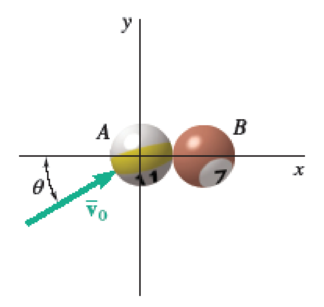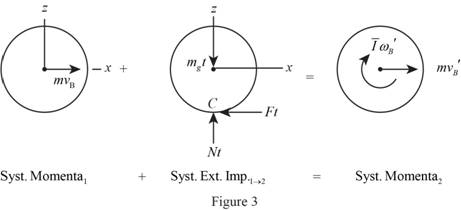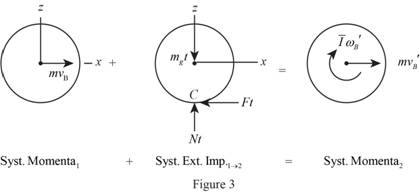
Concept explainers
In a game of pool, ball A is rolling without slipping with a velocity

Fig. P17.133
a)
The linear and angular velocity of each ball immediately after the impact.
Answer to Problem 17.133P
The linear velocity of ball A immediately after the impact is
The angular velocity of ball A immediately after the impact is
The linear velocity of ball B immediately after the impact is
The angular velocity of ball B immediately after the impact is
Explanation of Solution
Given information:
The mass of the each ball is m.
The radius of the each ball is r.
The velocity of the ball A before the impact is
The coefficient of kinetic friction between a ball and the table
Calculation:
Write the equation of moment of inertia
Analyze the impact of ball A.
Here, G is the mass center of ball A.
Consider the conservation of momentum principle.
Sketch the impulse and momentum diagram of the ball A as shown in Figure 1.

Here,
Refer Figure (1).
Consider the kinematics in position 1.
Write the equation of angular velocity
Consider the horizontal components of forces.
Consider the vertical components of forces.
Take moments about y axis.
Take moments about x axis.
Analyze the impact of ball B.
Here, G is the mass center of ball B.
Consider the conservation of momentum principle.
Sketch the impulse and momentum diagram of the ball B as shown in Figure (2).

Here,
Refer Figure (2),
Consider the horizontal components of forces.
Consider the vertical components of forces.
Take moments about y axis.
Take moments about x axis.
Add Equations (1) and (5).
The impact is perfectly plastic. Therefore ,the coefficient of restitution (e) is 1.
Consider the condition of impact equation.
Substitute 1 for e.
Find the horizontal components of linear velocity
Solve Equations (9) and (10) simultaneously.
Add Equations (9) and (10).
Find the horizontal components linear velocity
Substitute
Find the vertical components of linear velocity
Find the vertical components of linear velocity
Find the linear velocity
Substitute 0 for
Thus, the linear velocity of ball A immediately after the impact is
Find the linear velocity
Substitute
Thus, the linear velocity of ball B immediately after the impact is
Find the initial angular velocity of ball A using kinematics.
Find the angular velocity
Solve Equations (3) and (4) simultaneously.
Add Equations (3) and (4).
Substitute
Thus, the angular velocity of ball A immediately after the impact is
Find the angular velocity
From Equations (7) and (8).
Thus, the angular velocity of ball B immediately after the impact is
b)
Find the velocity of ball B after it has started rolling uniformly.
Answer to Problem 17.133P
The velocity of ball B after it has started rolling uniformly is
Explanation of Solution
Calculation:
Consider the motion after impact of ball B.
Consider C is the mass center of ball A.
Consider the conservation of momentum principle.
Sketch the motion of impulse and momentum diagram of the ball A after the impact as shown in Figure (3).

Here,
Consider the condition of rolling without slipping in kinematics.
Refer Figure (3).
Take moments about C:
Substitute
Find the velocity of sphere A after it has started rolling uniformly using the equation:
Substitute
Thus, the velocity of ball A after it has started rolling uniformly is
Consider the motion after impact of ball A.
Consider C is the mass center of ball A.
Consider the conservation of momentum principle.
Sketch the motion of impulse and momentum diagram of the ball B after the impact as shown in Figure (3).

Here, N is the normal force on ball A, F is the friction force between ball and floor, t is the rolling time,
Consider the condition of rolling without slipping in kinematics.
Refer Figure (3),
Take moments about C:
Substitute
Find the velocity of sphere B after it has started rolling uniformly using the equation:
Substitute
Thus, the velocity of sphere B after it has started rolling uniformly is
Want to see more full solutions like this?
Chapter 17 Solutions
VEC MECH 180-DAT EBOOK ACCESS(STAT+DYNA)
Additional Engineering Textbook Solutions
Automotive Technology: Principles, Diagnosis, And Service (6th Edition) (halderman Automotive Series)
Starting Out with C++: Early Objects (9th Edition)
Management Information Systems: Managing The Digital Firm (16th Edition)
Vector Mechanics For Engineers
Starting Out with Java: From Control Structures through Objects (7th Edition) (What's New in Computer Science)
Starting Out with Python (4th Edition)
- Part A: Suppose you wanted to drill a 1.5 in diameter hole through a piece of 1020 cold-rolled steel that is 2 in thick, using an HSS twist drill. What values if feed and cutting speed will you specify, along with an appropriate allowance? Part B: How much time will be required to drill the hole in the previous problem using the HSS drill?arrow_forward1.1 m 1.3 m B 60-mm diameter Brass 40-mm diameter Aluminum PROBLEM 2.52 - A rod consisting of two cylindrical portions AB and BC is restrained at both ends. Portion AB is made of brass (E₁ = 105 GPa, α = 20.9×10°/°C) and portion BC is made of aluminum (Ę₁ =72 GPa, α = 23.9×10/°C). Knowing that the rod is initially unstressed, determine (a) the normal stresses induced in portions AB and BC by a temperature rise of 42°C, (b) the corresponding deflection of point B.arrow_forward30 mm D = 40 MPa -30 mm B C 80 MPa PROBLEM 2.69 A 30-mm square was scribed on the side of a large steel pressure vessel. After pressurization, the biaxial stress condition at the square is as shown. For E = 200 GPa and v=0.30, determine the change in length of (a) side AB, (b) side BC, (c) diagnonal AC.arrow_forward
- Please solve in detail this problem thank youarrow_forward0,5 mm 450 mm 350 mm Bronze A = 1500 mm² E = 105 GPa प 21.6 × 10-PC Aluminum A = 1800 mm² £ = 73 GPa = a 23.2 × 10-PC PROBLEM 2.58 Knowing that a 0.5-mm gap exists when the temperature is 24°C, determine (a) the temperature at which the normal stress in the aluminum bar will be equal to -75 MPa, (b) the corresponding exact length of the aluminum bar.arrow_forward0.5 mm 450 mm -350 mm Bronze Aluminum A 1500 mm² A 1800 mm² E 105 GPa E 73 GPa K = 21.6 X 10 G < = 23.2 × 10-G PROBLEM 2.59 Determine (a) the compressive force in the bars shown after a temperature rise of 82°C, (b) the corresponding change in length of the bronze bar.arrow_forward
- The truss shown below sits on a roller at A and a pin at E. Determine the magnitudes of the forces in truss members GH, GB, BC and GC. State whether they are in tension or compression or are zero force members.arrow_forwardA weight (W) hangs from a pulley at B that is part of a support frame. Calculate the maximum possible mass of the weight if the maximum permissible moment reaction at the fixed support is 100 Nm. Note that a frictionless pin in a slot is located at C.arrow_forwardIt is the middle of a winter snowstorm. Sally and Jin take shelter under an overhang. The loading of the snow on top of the overhang is shown in the figure below. The overhang is attached to the wall at points A and B with pin supports. Another pin is at C. Determine the reactions of the pin supports at A and B. Express them in Cartesian vector form.arrow_forward
- Recall that the CWH equation involves two important assumptions. Let us investigate how these assumptions affect the accuracy of state trajectories under the control inputs optimized in (a) and (b). (c.1): Discuss the assumptions about the chief and deputy orbits that are necessary for deriving CWH.arrow_forwardPROBLEM 2.50 1.8 m The concrete post (E-25 GPa and a = 9.9 x 10°/°C) is reinforced with six steel bars, each of 22-mm diameter (E, = 200 GPa and a, = 11.7 x 10°/°C). Determine the normal stresses induced in the steel and in the concrete by a temperature rise of 35°C. 6c " 0.391 MPa 240 mm 240 mm 6₁ = -9.47 MPaarrow_forwardFor some viscoelastic polymers that are subjected to stress relaxation tests, the stress decays with time according to a(t) = a(0) exp(-4) (15.10) where σ(t) and o(0) represent the time-dependent and initial (i.e., time = 0) stresses, respectively, and t and T denote elapsed time and the relaxation time, respectively; T is a time-independent constant characteristic of the material. A specimen of a viscoelastic polymer whose stress relaxation obeys Equation 15.10 was suddenly pulled in tension to a measured strain of 0.5; the stress necessary to maintain this constant strain was measured as a function of time. Determine E (10) for this material if the initial stress level was 3.5 MPa (500 psi), which dropped to 0.5 MPa (70 psi) after 30 s.arrow_forward
 Elements Of ElectromagneticsMechanical EngineeringISBN:9780190698614Author:Sadiku, Matthew N. O.Publisher:Oxford University Press
Elements Of ElectromagneticsMechanical EngineeringISBN:9780190698614Author:Sadiku, Matthew N. O.Publisher:Oxford University Press Mechanics of Materials (10th Edition)Mechanical EngineeringISBN:9780134319650Author:Russell C. HibbelerPublisher:PEARSON
Mechanics of Materials (10th Edition)Mechanical EngineeringISBN:9780134319650Author:Russell C. HibbelerPublisher:PEARSON Thermodynamics: An Engineering ApproachMechanical EngineeringISBN:9781259822674Author:Yunus A. Cengel Dr., Michael A. BolesPublisher:McGraw-Hill Education
Thermodynamics: An Engineering ApproachMechanical EngineeringISBN:9781259822674Author:Yunus A. Cengel Dr., Michael A. BolesPublisher:McGraw-Hill Education Control Systems EngineeringMechanical EngineeringISBN:9781118170519Author:Norman S. NisePublisher:WILEY
Control Systems EngineeringMechanical EngineeringISBN:9781118170519Author:Norman S. NisePublisher:WILEY Mechanics of Materials (MindTap Course List)Mechanical EngineeringISBN:9781337093347Author:Barry J. Goodno, James M. GerePublisher:Cengage Learning
Mechanics of Materials (MindTap Course List)Mechanical EngineeringISBN:9781337093347Author:Barry J. Goodno, James M. GerePublisher:Cengage Learning Engineering Mechanics: StaticsMechanical EngineeringISBN:9781118807330Author:James L. Meriam, L. G. Kraige, J. N. BoltonPublisher:WILEY
Engineering Mechanics: StaticsMechanical EngineeringISBN:9781118807330Author:James L. Meriam, L. G. Kraige, J. N. BoltonPublisher:WILEY





